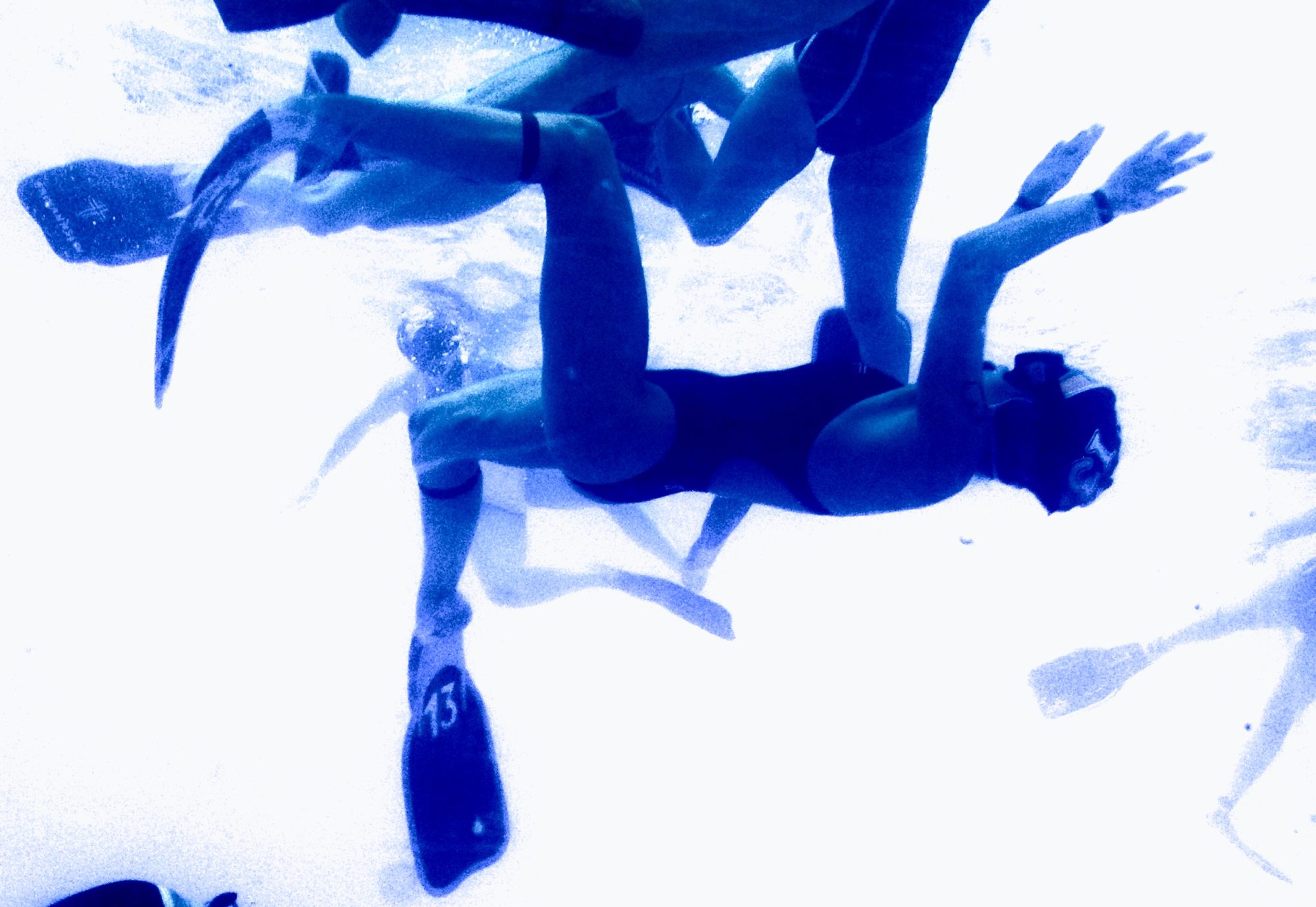Expulsion of underwater rugby from the Swedish Sportdiving Federation (SSDF) could lead to independent recognition by CMAS.
The relationship between underwater rugby and sport diving is so bad that a leading diving club wants to kick the ball sport out of the federation. As previously reported, at the Swedish Sportdiving Federation (SSDF) general meeting this September the members will vote on a motion to entirely shut down the organization’s involvement in underwater rugby as a sport in Sweden.

This development would not necessarily affect Swedish rugby’s national teams. CMAS President Anna Arzhanova said that a new Swedish national rugby association could request documents to apply for independent recognition.
“Fill them in, sign them and send them back to headquarters,” she said. “Should you need more information do not hesitate to call me.”
As with many sports the international schedule is up in the air because of the Coronavirus pandemic. The next international competition should be the 2021 European Championships in Stavanger.
The Chairman of SSDF, Henrik Johansson, has advised the members to vote against the motion. However, the club that filed the motion, SDK Näcken, is the home club of Mats Gunnarsson, the Chairman of SSDF’s [scuba] Diving Committee. It is unclear whether Gunnarsson or Johansson will command a majority when it comes to a vote.*
Although a few Swedish rugby players would be happy to set out on an independent course, the majority are anxious not to see their sport lose its official status within SSDF, a member of the Swedish Sport Confederation.
Background to conflict
Along with the motion to eject rugby, Näcken submitted an explanatory document. Näcken Chairman Gunnar Larsson—the author of the background note—observed that acrimony on social media had had a negative impact on relations between rugby and the federation. He briefly described three points of dispute:
The expense of the office in Stockholm;
The lack of reporting on rugby in Sportdykaren, the federation’s glossy print magazine;
The general competence of SSDF’s leadership and administration.
He went on to say that the annual meeting should not engage in a discussion of who has been right or wrong in the conflicts between rugby and the federation leaders. The goal of Näcken’s motion is simply to put an end to an unhappy relationship. The motion does not propose any financial compensation to rugby. Nor is there any scheme to divide assets. One could call Larsson the advocate of a no-fault divorce between two unequal parties.
What on social media offended the divers? The explanatory document does not mention any particular incident or episode. Still, it is easy to find examples. In 2016, when the leaders of SSDF decided to shore up the organization’s shaky finances by introducing an annual 300 kronor (29 euro) competition license for underwater rugby players and freedivers. The income from the license would, the board promised, go entirely to the respective sports committees to use for the purposes they saw fit.
Rugby players and freedivers had never paid more in annual membership fees than scuba divers, so there was understandably reluctance. However, when it came to a vote, divers enjoyed a majority, for only about 6 percent of SSDF’s 6,000 members were rugby players. The proposal could (and would) be passed, regardless what the athletes thought.
Sweden, though, is a consensus based society and confrontation is considered undesirable. Accordingly, SSDF’s leaders made an effort to sell the idea. In August 2016, Gunnarsson introduced himself to the Swedish rugby group on Facebook that is commonly used to communicate what is happening in the country. The Diving Chairman himself had a strong background in rugby. With legitimacy he could and did make a sales pitch from a rugby point of view:
“My name is Mats Gunnarsson. I play [rugby] for Nautic but was rugby schooled in Näcken… I have several Swedish National Championship medals from the golden days with Näcken and now I just play in Division 1 for fun.”
He added that he was also Chairman of SSDF’s technical [diving] committee.
To begin with he noted that diving instructors have paid a license fee for 10 years. Why the instructors license was the equivalent of a competition license he did not elaborate. Importantly, he noted that economic relationship between rugby and diving had wrongly favored rugby.
“As I see it underwater rugby has raked in the gold from SSDF for many years,” argued Mats Gunnarsson, Chairman of the Diving Committee at the Swedish Sportdiving Federation.
He offered two reasons for this. Firstly, underwater rugby had had “clever” and “motivated” lobbyists who had worked in the interests of their sport. He specifically mentioned Kajsa Lindman, who is today the head of the underwater rugby committee.
Secondly, rugby had exploited a myth that without rugby, SSDF would not have qualified for subsidies from the Swedish Sports Confederation, the distributor of hundreds of millions of euro each year. Diving, rugby players were fond of saying, was not a sport. SSDF could only be a member of the confederation thanks to he inclusion of rugby.
A diver had investigated the matter and learned that scuba diving was a legitimate recipient of state funding in its own right. Diving was not at all beholden to rugby. Suddenly, divers realized that paying for Swedish rugby teams to represent the country in international competition had been unnecessary. Resentment over the expense of the team sport became a grievance.
Gunnarsson, who had access to SSDF’s financial information, made assertions about how much money rugby had gotten in the past. The new fee would allow diving to keep more money, compensating diving. The divers’ point of view was new to many rugby players. The majority posting on the thread in reply to Gunnarsson expressed gratitude for his presentation.
Still, his argumentation did not go entirely unchallenged. One rugby player questioned whether it was correct for member of the board to cite budgetary numbers in a Facebook discussion without providing public access to the complete budget figures. Another player pointed out that some subsidies were tied to reported athlete per hour training, a contribution that rugby club practices generate. There are more juniors in rugby than in scuba diving, another factor that increases the subsidies from the Swedish Sport Confederation.
In any case, the license fee was adopted. Ill feeling, though, did not disappear over the next three years. The Stockholm club Polisen has now submitted a motion to scrap the competition fee and work out a new system. SSDF’s Board admitted that he competition license had had created problems and suggested that it that it run the licenses through an online platform provided by the Swedish Sport Confederation. This, too, will come up for a vote in September.
Where the money actually goes
The Näcken note observes that today rugby actually is already largely self financing. It states that Swedish league competition is run almost completely by rugby. The Underwater Rugby Committee plans the schedule of play. The clubs themselves book pool time and pay the rental costs of facilities. The Committee ensures that referees attend. The referees’ travel costs and the league fees are collected by committee. As for the Swedish Championships, the Committee had in the past partially financed the championship, but now the participation fee covers the cost of the Swedish Championships.
“So you can say that league play and Swedish Championships are financed by the clubs themselves,” stated Larsson, implying that rugby would not lose much money from government funding because it did not receive much in any case.
He does not cite a source for the financial information.
SSDF’s annual reports do not separately break down cost and income comparisons for diving, freediving and rugby. This reporter has heard on several occasions that the nitty-gritty working budget details are provided to the chairman of each sport. This shared information is the basis of the internal negotiations on how to divide funding between various competing interests.
In underwater rugby it is the national teams that are the big cost,”
—Mats Gunnarsson
Chairman
Diving Committee Swedish Sportdiving Federation
It would seem that shedding the national teams to cut costs and labor could be an aim of the motion to expel the sport. But how much the national teams actually receive is not public. At the last World Championships in Graz, Swedish national team players bought their own uniforms. Each player paid 15,000 kronor (1,488 euro) to participate.The fate of the national teams
The explanatory note discusses how the national teams could continue to exist after the expulsion of rugby. Larsson suggests that a new underwater rugby association could be established. The new association would then negotiate an agreement with SSDF to handle the CMAS license provision for the European and World Championships, the only two competitions requiring SSDF approval.
In such a scenario, SSDF would not have to pay anything at all towards national teams and perhaps gain income from the Swedish Sport Confederation elite sport subsidy.
The alternative would be the founding an entirely independent association to join CMAS. There are numerous examples of countries having multiple CMAS memberships. Argentina, for example, has one federation for diving and another for hockey. An independent Swedish underwater rugby organization could pay the federation membership fee but not receive any CMAS voting rights that would infringe SSDF’s rights in other matters. It would only pay for membership in the rugby section, where it would have the right to vote. This would not affect SSDF since the Swedish federation would not have rugby as an activity.
International referees
Sweden has been a key nation when it comes to running underwater rugby as an international sport. Four international referees, including the CMAS Chief Referee, are Swedes. Manuel Tito de Morais, the sport’s chief referee, said that he did not believe he would be eligible to serve if SSDF quit rugby.
“To referee Champions Cup would not be a problem, I think, but the European and World Championships would probably not be allowed as we would not have CMAS association any longer,” said Tito de Morais. “I would probably not be able to stay on as Chief Referee.”
He added that he might try to gain membership through another federation so that he could continue officiating the sport. Founding and administering an independent Swedish rugby association seemed like a great deal of work, according to him.
The sport would have to scramble rugby to salvage its records, both paper and electronic, among other difficulties. There are several unknowns. Could rugby clubs join the Swedish Swimming Federation to restore their connection to the Swedish Sport Confederation? Could the Swedish National Championships retain their legal status?
However, leaving the diving federation might not be a bad thing, according to some.
“I know a number of groups who would love to be in Swedish rugby’s position,” commented Graham Henderson, President of the Australian Underwater Federation
The vote to expel rugby is scheduled for the 27th of September.
* In 2018, he coached the Swedish Women’s National Team at the Nordic Championship in Katrineholm.

